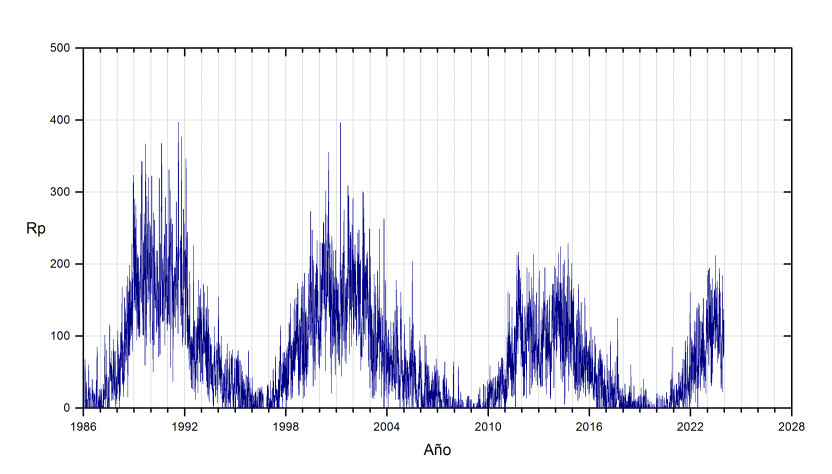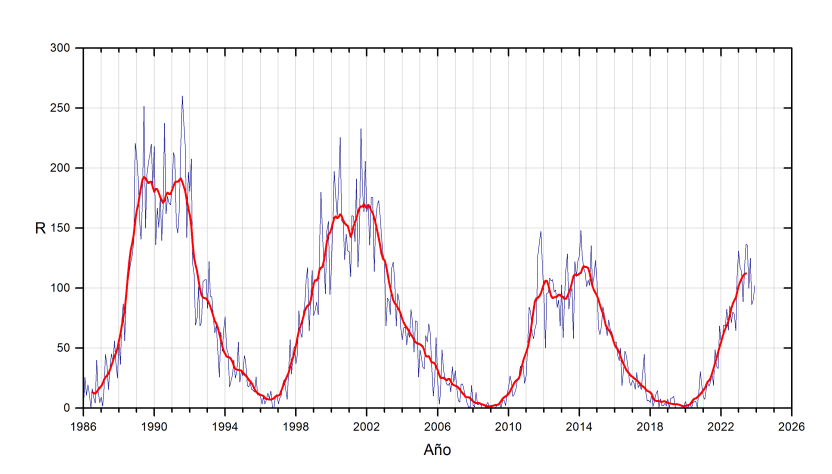

WOLF NUMBERS |
 |
 |
The Wolf numbers in the previous lists have been corrected to obtain a more homogeneous series, reducing as much as possible the differences caused by the observation conditions, as well as the ups and downs produced by very discrepant observations, trying not to eliminate too much data to conserve continuity. In the final series, approximately 1% of the days lack data.
The method used was the following:
1.- First, the whole series was revised to eliminate duplicate or erroneous data and non-individual reports (collective reports made up of associations or observation groups), because the latter have already been previously treated, or lack the necessary homogeneity to be treated later.
Some reports are made by a main observer, but include data from other observers to complete the days not observed. When they can be identified, only the data of the main observer has been preserved.
The series begins in 1986 because in earlier dates the data and observers are too few to be properly treated.
2.- Each data Rij is identified by 2 subscripts, associated respectively with the day and the observer. The daily averages of all data Ri are calculated when the data number is n> 2
3.- The factors Kij for each day and observer are calculated: Kij = Ri / Rij excluding Rij = 0
4.- For each observer, the monthly averages of Kij and their standard deviation s are calculated, provided that n> 2
5.- The Kij values whose discrepancy with Kj is greater than sigma are eliminated. Abs (Kij - Kj) > sigma
6.- The averages Kj are recalculated when n> 2
7.- Those months in which n < 3, Kj is determined by averaging the values of the previous 3 months. When this is not possible either, the data of that observer is suppressed during that month.
8.- The data Rij are multiplied by the corresponding Kj to obtain the corrected values R'ij All the Rij = 0 are included, since it is indifferent whether they are multiplied or not by Kj.
9.- The daily averages R'i and its standard deviation are calculated, when n> 2
10.- The values R'ij whose discrepancy of R'i is greater than 2 * sigma are eliminated. Abs (R'ij - R'i)> 2 * sigma In the absence of many observers, a value of 1 * sigma would leave us with a very incomplete series.
11.- The daily averages are recalculated when n> 2, to obtain the definitive R values.
Those days when n = 1, the values of R'ij are not directly eliminated, but filtered as follows. First the value for that day is interpolated from the data of R immediately before and after. Then the standard deviation sigma is calculated, using the 10 days before and after. If the difference between R'ij and the interpolated value is less than sigma, R'ij is included in the definitive series; otherwise, it is considered that day lacks data. If n = 2 the same is done with the average of both data.
This type of filter eliminates some more discrepant observations depending on the solar activity. When the activity is stable, it allows less discrepant values than when it presents strong ups and downs. The half-interval of 10 days has been chosen empirically, observing its effect in different instants of the series. Using fewer days, in general, makes the filter more severe, eliminating more measures. On the contrary, it is very permissive using a larger interval, making its effect insignificant.
The described treatment acts mainly, reducing somewhat the dispersion in the daily values, especially in the phases of greater activity. In principle, the average should not vary, when used as a reference to calculate the K factors. However, the fact that the treatment reduces or eliminates the peaks associated with days with few observers, and that does not alter the days with Rij = 0 , tends to decrease to a certain extent the monthly averages.
The first list includes the daily averages and the columns correspond to the date, Wolf number, standard deviation and number of observations included in the average. When n <3, sigma = 999.99 has been taken to avoid empty entries.
The second list includes the monthly averages. The columns correspond to the month in the format "yyyymm", Wolf number, and standard deviation.